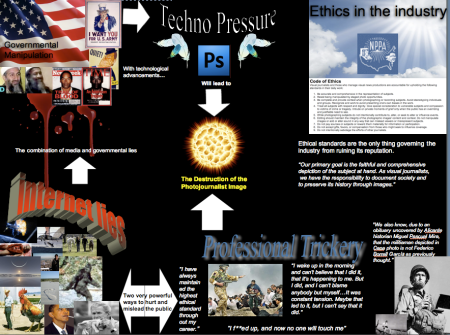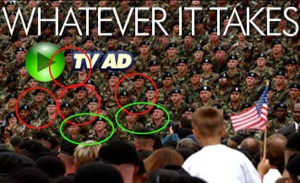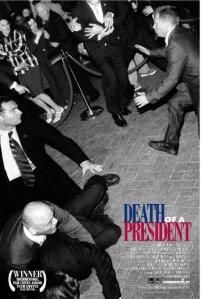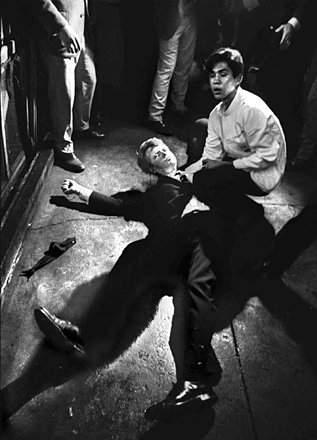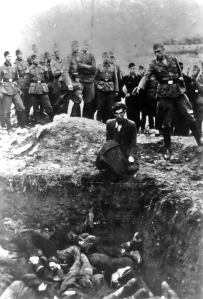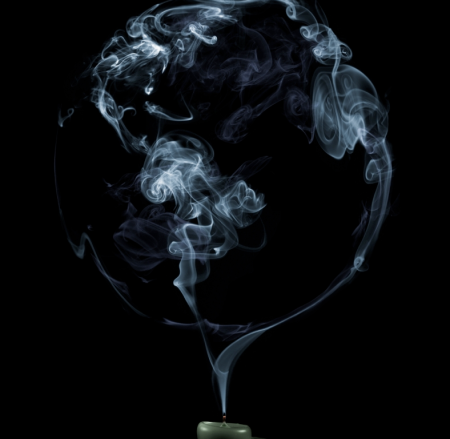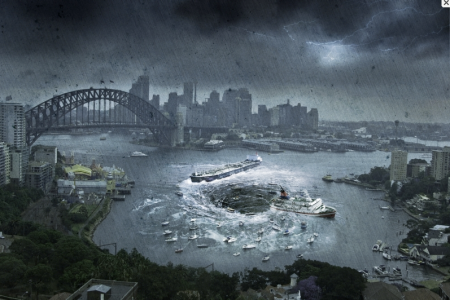
i-MAP
November 11, 2009
Bibliography
November 11, 2009Internet Sources
http://911lies.org/fake_bin_laden.html
http://www.artistsofphotoshop.com/
http://blog.puppetgov.com/wp-content/2008/03/rfk_shot2.jpg
http://blogs.photopreneur.com/the-worlds-most-famous-photoshop-fakes
http://blogs.photopreneur.com/worlds-most-infamous-staged-photos
http://bradley.chattablogs.com/mlk_jr_slaying.jpg
http://en.wikipedia.org/wiki/Adobe_Photoshop
http://en.wikipedia.org/wiki/Brian_Walski
http://en.wikipedia.org/wiki/Spirit_photography
http://heim.ifi.uio.no/~gisle/blog/?p=404
http://mypetjawa.mu.nu/archives/OJ_Simpson_Newsweek_TIME.png
http://oddee.com/item_96803.aspx
http://samchok.or.kr/files/attach/images/1067/791/011/kevin-carter-vulture.jpg
http://web.mit.edu/cms/bcc/blogpics/propaganda_prozac.gif
http://www.blogcdn.com/www.downloadsquad.com/media/2005/09/PhotoshopCS
http://www.boingboing.net/200708071607.jpg
http://www.buzzle.com/articles/the-subliminal-message-does-it-really-work.html
http://www.cosmosmagazine.com/files/imagecache/feature/files/20061101_buzz.jpg
http://www.cs.dartmouth.edu/farid/research/digitaltampering/marthastewart1.jpg
http://www.democraticunderground.com/discuss/duboard.php?az=view_all&address=132×1197358
http://www.junipermedia.net/nucleus/media/1/20070211-walski.jpg
http://www.nppa.org/news_and_events/news/2009/07/capa.html
http://www.nppa.org/professional_development/business_practices/ethics.html
http://www.nppa.org/professional_development/business_practices/ethics.html
http://www.pbs.org/wnet/americanmasters/episodes/robert-capa/in-love-and-war/47/
http://www.photoshopuserawards.com/winners.php
http://www.spd.org/images/blog/184.jpg
http://www.washingtonpost.com/wp-srv/photo/essays/vanRiper/030409.htm
http://www.worth1000.com/galleries
http://www.youtube.com/watch?v=4YbzqlVtpXE&feature=related
http://www.youtube.com/watch?v=6yhX9OMmrsA&feature=player_embedded
http://www.youtube.com/watch?v=uqzIpo53w7E
Book Sources
- Dirck Halstead (2006), Moments In Time. Harry and Abrams Inc
- Liz Curtis (1984), Ireland:The Propaganda War. London: Pluto Press
- Phillip Knightley (1975). The First Casualty. London: Carlton Publishing Group
- William J. Mitchell (1992) The Reconfigured Eye: Visual Truth in the Post-Photographic Era. London: MIT Press

The Writing Plan
November 11, 2009
Brian Walski Photo
Writing Plan
Intro
o Walski and the world he lived in
o Broader extent-what photojournalists have to do on a day to day
o The scandal and what exactly happened
o The repercussions
Body
o The concept of deceit
o How it can be used – gov, propaganda, advertising, sublim, staging (examples)
o Brief History – Spirit Photography
o Capa VS Walski (who,when, what makes them similar/diff)
Conclusion
o Ethics that challenge the industry and why
o Aftermath: damaging the credibility of photojournalism

The Study Diary
November 10, 2009After seeing the picture and doing a very basic search of the topic, I decided to choose the Brian Walski photo to base on my study blog. The picture turns out to be a composite of two separate photos. Brian Walski adjusted the pictures to form a third, ‘ideal’ picture to publish to the LA Times. I was initially shocked that pictures could circulate and make their way to legitimate newspapers without being thoroughly checked out or inspected. I had obviously heard of fake and hoax photos about UFO’s, aliens and celebrities but the intrusion into photojournalism hadn’t sunk in yet. It seemed I was more curious to know what had happened to Brian Walski after the discovery had been made as opposed to why he did it. I think this was because I assumed the reason behind why Walski faked the picture was simply for career or financial reasons.
The second post was concluded after researching and finding out the extent of Walski being fired. The blog quotes Walski and a friend who converse over the matter and I discovered the state that Walski was described. I included it in my post as a sort of shock to what had happened to him. I was shocked myself as to his state, especially when hearing that he didn’t try to justify or deny the accusations.
After thinking about the whole Walski scenario and how he seemed to be made an example of, I wanted to simply see what else was out there on the Internet, and on quite a superficial and almost trivial basis. The research lead me to a lot of tabloid hoaxes about celebrity dates and ‘shocking pictures’ and actually quite bored me.
The point of that section of research was just to simply get a grip with the understanding that these days manipulation in any form seems more popular than ever.
Soon after being bored with tabloid prints of Brad and Angelina on the beach, I tried to take a different approach by taking this topic to its furthest extreme, which seems to be subliminal messaging. The main connection that I made between the two was simply the deceit and its goals.
After moving on to staging photos I found myself confidently doing the research with more passion. The topic seemed to interest me a lot more when I was finding genuinely relevant and interesting posts. I was interested in the fact that photojournalists tampering with what they consider ‘the scene’ to their advantage was quite interesting and how sneaky their intentions can be. After seeing so many photos (some included in the post) it almost dawned on me how many times I had seen something similar. There had been countless times that I had seen a memorable child’s toy in some sort of bomb rubble or wreckage and it almost shed a light on the not so innocent world of photojournalism.
This mentality took me to the other posts, learning about myself that the darker side of an industry or person seems to interest me more than anything else. I’ve always been interested in what seemed more unknown to me, such as conspiracies and finding out what ‘wasn’t supposed to be seen’. And so I think this mentality guided the rest of my research, looking for something I had never seen or heard before. This was definitely achieved after learning about Spirit Photography and how the media uses its dark side in the media with propaganda.
Concerning time management I feel like I handled the blog well, spacing out my entries with time to reflect but as the entry dates show I usually followed my research with another entry when interested, and when I wasn’t, I stopped. The time management was also a bit harder than originally perceived because my flat doesn’t have Internet yet and so the research had to be done at school at certain times as opposed to natural, motivated research.
After using famous war photos as evidence to suggest that this has been going on for decades I felt as if my research was coming to slow stop. The Robert Capa information about his fake especially interested me because of all the attention it gathered so far after its original release. The comparison to Walski seemed similar enough to weigh them against each other because of their reputations and what it their forgeries had done to them.
I picked up my research again with interest after seeking ‘the best of photoshop’ to discover the world of recognition and talent that follows the photo illustration industry. This research progressed into the ethical boundaries that the photography industry faces and how they can challenge photographers to do their job accurately. I felt as if the artists on websites like www.artistsofphotoshop.com, www.worth1000.com and many more really do deserve the recognition that they get because they are truly talented at what they do, contrary to the debatable ethics. My research lead me to find the people who didn’t have any debate over their photos, and who have created visual milestones in our history. The first was Robert Kennedy’s death, showing the dying man lying on the ground surrounded by people. The photo has captured his pain and the presence of death has never seemed so real. The second photo was chosen because this is one of the biggest achievements in our scientific world and the photos and footage that came from the moon landing will be forever remembered. Concerning the moon landing as a mission there is serious speculation towards the legitimacy of the operation especially regarding the issued photos. I am aware of the blatant irony that I have included one of the most famous photos as legitimate when there is ample speculation over its authenticity but I feel as if the debate over the moon landing highlights my argument. The moon landing is a historical moment and the fact that its validity is debatable only highlights the fact that photo alteration and manipulation is more evident than it has ever been. If the moon landing was real then the photo deserves to be on the top of anyone’s list, but if fake then I think it deserves equal recognition because it could well be ‘the most famous fake’. ‘The Last Jew of Vinnitsa’ is powerful in the sense that it really does sum up the atrocities of WW2 and everything that it entailed and I felt almost obligated to include it. The Kevin Carter photo of the small, starving African child being preyed upon won him the Pulitzer prize and has made an impact on his work, and also my mind. I chose those certain photos becaue they all have a lot to say in them and the historical implications before and after are really important. One thing that I noticed also was that the majority of the photos involved death and that death on camera is usually rare enough to shock people into thinking harder about the image. Death in any circumstance draws out a lot of emotion and to have death freeze framed right in front of you can make a photo really worth more than a thousand words.
The final piece of the blog; the conclusion was made to try and get across the feeling that I had gotten over my time researching the photojournalist industry. The fakes that had flooded my screen after hours and hours of research, and news of Walski, Capa, Rosenthal and Rothstein using fakes made my trust and faith keep decreasing. The honesty from photographers is undeniably evident when comparing the real photos to all the fake photos but the fact remains that fakes are making their way across all avenues of our lives, which will only make trusting other photos even harder. The distrust in the industry saddens me because I can recognise the very acute talent that needs to go into the process and although we might have been dealing with fakes for years, I feel it will only get worse.

Conclusion: The Death of Photojournalism
November 10, 2009The research over Brian Walski and his fake have lead me through different ways of photo manipulation, using it for government, during history and most importantly, the impact it has had.
The impact that the dishonesty and misuse of photography has lead to the slow death of the photojournalist image.
The public is loosing faith in the photographic industry because of the amount of fakes that have recently risen and we have reached the point of debating a photos authenticity before getting drawn-in to a photo. The public are constantly bombarded with what are told to be real pictures and when this game leaks into the media, using fakes in magazines, news reports and even campaigns the public has reached a point to simply not trust their first instinct, destroying the image of the industry.
The integrity of the people who take the pictures is also at risk because the public, and even those employing photographers need to make sure that what they are seeing is real. The wasted time and efforts in making sure the picture is real can be costly and unesseary when dealing with a proffesion that demands honest and accurate journalism. The faith in photojournalism is being lost even amongst the peers of the industry as people are becoming more sceptical of each others work, making sure no one is doing the forbidden deed.
The honest art of photography may still be as relevant as it has been in the past but the simple truth that history has played out for us is that the industry is simply harder to trust. The chances of making a concrete decision about a debatable photo fake is unlikely and so this will always discourage individuals to dispute it. Because of this there seems to be a gap in the connection between modern photography and the public because there is so much to discuss. With the technological advancements that have dominated the industry so far, changing photography from what we knew it to now an undeterimined industry. Because of this the image of photojournalism is being destroyed , not the practice itself or the industry but the image. The industry is getting stronger, with more photojournalists across the world and with all the uses of new media it will grow, however the reliability, perspective and direction that it is going is under scrutiny.
The future of the industry is at risk because from the speed of technological improvements and we will be sure to see more controversy over fake pictures, videos and news which unfortunetly chips away at the integrity of photographers across the world.
During the final discussion of this topic i remembered one documentary that stuck in my mind and now I realise why. The documentary was based all upon a fake event, but by simply changing the truth a very powerful and effective documentary was made, The Death of A President.
http://www.youtube.com/watch?v=4YbzqlVtpXE&feature=related 10/11/09
The link above shows a trailer to the film The Death of A President, a documentary following the fictional investigation of the George W. Bush assassination.

The Best
November 9, 2009So far I have dealt with the photography industry’s dealings with fakes and the people who do them. But one element of the discussion that needs adressing are the exceptionally good photos.
There are a series of photos that will stick with us throughout human existance, and photography is one of the great art forms that is used as a timeline. As discussed this timeline can be manipulated due to changing factors today but there are photos that define truth in our history. Correct ethics and morals have taken photojournalists across the world and have lead us to reach what we can consider ‘the best photography’.
One should ask ones self some questions when debating the clarity of photography.
Why have we trusted photography to this point?
photography has been used as a visual timeline throughout its history and whetehr we realise or not, the public deals with pictures telling the story every day. In magazines we look at the picture first, then the article and in a newspaper we do the same. We are almost conditioned to look at the pictures, and some even prefer just flicking through them. We trust an image in a magazine because its credibility got it to that point and the article usually reflects it. Due to changing technological factors, these elements are slowly shifting, making it harder to apply the same habits to new things. For example alot of people wouldn’t know whether to debate the fakeness or truth behind any given image because we haven’t been fooled so much before and the concept still seems new.
What can a fake picture do to our historical timeline?
A fake picture can seriously damage our historical timeline as Robert Capa’s picture now tells a different story. Not only is the historical referencing different now but the trust in photojournalism during that time is now debatable. The discovery of any fake in our massive database of photos on this planet only further highlights the dishonesty of the industry. Fake pictures will destroy jobs and companies and for an ever changing technological present and future, will blur our historical references to the point of no return.
The following photos are a selection of some of the considered best, and that i personally find very powerful.
The first is Boris Yaro’s photo taken at 12: 15 am, moments after Robert Kennedy was shot walking through the kitchen of The Ambassador Hotel.
http://blog.puppetgov.com/wp-content/2008/03/rfk_shot2.jpg 08/11/09
The next photo is of the first moon landing, with man walking on another planet for the first time in history.
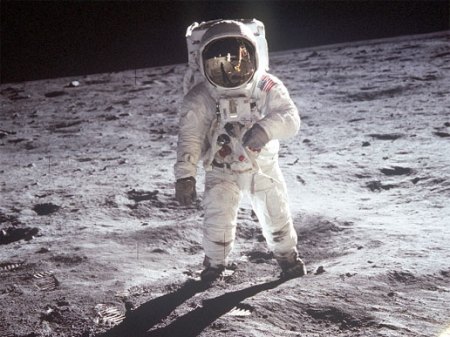 http://www.cosmosmagazine.com/files/imagecache/feature/files/20061101_buzz.jpg 07/11/09
http://www.cosmosmagazine.com/files/imagecache/feature/files/20061101_buzz.jpg 07/11/09
The picture below was found on an Einsatzguppen German soldier written, ‘The Last Jew of Vinnista’.
08/11/09
The sadening picture below was taken by Kevin Carter, depicting the harsh and tradgegic life of African children.
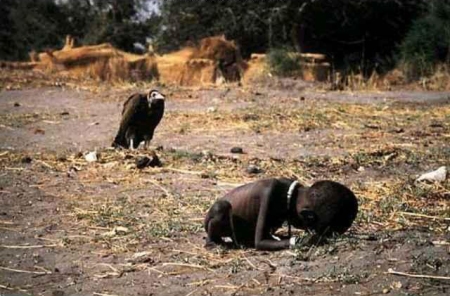 http://samchok.or.kr/files/attach/images/1067/791/011/kevin-carter-vulture.jpg 07/11/09
http://samchok.or.kr/files/attach/images/1067/791/011/kevin-carter-vulture.jpg 07/11/09
The picture below was taken moments after the assasination of Martin Luther King on a hotel balcony.
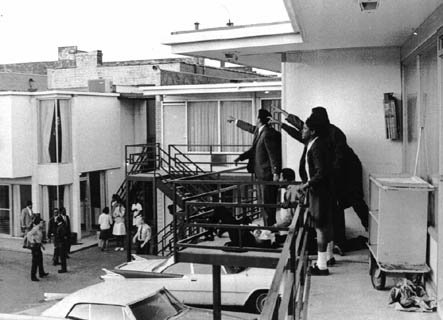 http://bradley.chattablogs.com/mlk_jr_slaying.jpg 08/11/09
http://bradley.chattablogs.com/mlk_jr_slaying.jpg 08/11/09

Ethics
November 8, 2009In Walski’s industry honesty is key, and trickery will only promote mistrust in your fans and will tarnish your reputation in your career. For those simple reasons it seems only natural to have a set of guidelines that should be abided to.
I found the NPPA Code of Ethics,
”The National Press Photographers Association, a professional society that promotes the highest standards in visual journalism, acknowledges concern for every person’s need both to be fully informed about public events and to be recognized as part of the world in which we live.” http://www.nppa.org/professional_development/business_practices/ethics.html 08/11/09
after searching the ‘rules’ of photography and to see if when a line was crossed, what really happened next?
The following section was taken from the NPPA website:
http://www.nppa.org/professional_development/business_practices/ethics.html 08/11/09
Code of Ethics
Visual journalists and those who manage visual news productions are accountable for upholding the following standards in their daily work:
- Be accurate and comprehensive in the representation of subjects.
- Resist being manipulated by staged photo opportunities.
- Be complete and provide context when photographing or recording subjects. Avoid stereotyping individuals and groups. Recognize and work to avoid presenting one’s own biases in the work.
- Treat all subjects with respect and dignity. Give special consideration to vulnerable subjects and compassion to victims of crime or tragedy. Intrude on private moments of grief only when the public has an overriding and justifiable need to see.
- While photographing subjects do not intentionally contribute to, alter, or seek to alter or influence events.
- Editing should maintain the integrity of the photographic images’ content and context. Do not manipulate images or add or alter sound in any way that can mislead viewers or misrepresent subjects.
- Do not pay sources or subjects or reward them materially for information or participation.
- Do not accept gifts, favors, or compensation from those who might seek to influence coverage.
- Do not intentionally sabotage the efforts of other journalists.
Ideally, visual journalists should:
- Strive to ensure that the public’s business is conducted in public. Defend the rights of access for all journalists.
- Think proactively, as a student of psychology, sociology, politics and art to develop a unique vision and presentation. Work with a voracious appetite for current events and contemporary visual media.
- Strive for total and unrestricted access to subjects, recommend alternatives to shallow or rushed opportunities, seek a diversity of viewpoints, and work to show unpopular or unnoticed points of view.
- Avoid political, civic and business involvements or other employment that compromise or give the appearance of compromising one’s own journalistic independence.
- Strive to be unobtrusive and humble in dealing with subjects.
- Respect the integrity of the photographic moment.
- Strive by example and influence to maintain the spirit and high standards expressed in this code. When confronted with situations in which the proper action is not clear, seek the counsel of those who exhibit the highest standards of the profession. Visual journalists should continuously study their craft and the ethics that guide it.
The sincerity of the industry seems legitimate and from the guidelines and policies it seems that honesty really does mean everything, ”Visual journalists operate as trustees of the public. Our primary role is to report visually on the significant events and varied viewpoints in our common world. Our primary goal is the faithful and comprehensive depiction of the subject at hand. As visual journalists, we have the responsibility to document society and to preserve its history through images.” http://www.nppa.org/professional_development/business_practices/ethics.html08/11/09

So Who Can Pull It Off?
November 5, 2009The catching and exposure of these photo fakers makes me wonder who are the people that can pull it off, but not only legally, but be recognised for it too.
Photoshop, the manipulation programme developed by Adobe that has taken teh world of photography by storm is commonly used today to intentionally manipulate and perfect any given photo. The program has encouraged competitors world wide and sparked millions of circulating photos of what seems could be real. Contrary to all the fakes going around the world, there are talented artists whose either job or hobby it is to use photoshop to its fullest extent.
“It is the current market leaderfor commercial bitmap and image manipulation software, and is the flagship product of Adobe Systems. It has been described as “an industry standard for graphics professionals”[1] and was one of the early “killer applications” on the Macintosh, later also for the PC.“
http://en.wikipedia.org/wiki/Adobe_Photoshop 05/11/09
![]()
http://www.blogcdn.com/www.downloadsquad.com/media/2005/09/PhotoshopCS2Icon.jpg
The photoshop user awards website is used to recognise these talented artists who seem to put the deceitful programe to good, honest use.
http://www.photoshopuserawards.com/winners.php
Some of the best in the photoshop world include the Dwight Pritchett photo ‘No Air’.
http://www.photoshopuserawards.com/winners.php 05/11/09
Photo Illustration is the art form using computer software and photo imaging to form a piece of art. The use of Photoshop and similar programmes is clearly recognised and the issue of ‘fake or real’ doesn’t come close to discussion. In the world of photo illustration the reality of the photo isn’t relevant and the use of the software to ones best ability is rewarded and recognised. The pictures below and above show the talent gone into photo illustration and can be used in journalism.
http://www.spd.org/images/blog/184.jpg 05/11/09
As mentioned earlier, there is no debate whether or not the image is a fake, or is dishonest because the industry has recognised itself clearly so that no argument can be debated. I ask myself if Brian Walski knew the issues he was dealing with and what would happen if he crossed the dangerous line. There seems to be no ‘ethical’ pressures in the Photoshop world or photo illustration, even in modern advertising but I wanted to know if Walski had seriously broken a set of rules.

‘Famous WAR Photo Fakes’
November 3, 2009As discussed in the earlier post, some photos have been exposed as being misleading and untruthful and Robert Capa’s Spanish solider being shot in the head was no different.
”When The Falling Soldier was published in the July 12, 1937, issue of Life magazine, the caption stated, “Robert Capa’s camera catches a Spanish soldier the instant he is dropped by a bullet through the head in front of Córdoba.” Over the following years and decades, during and after Capa’s death, the photograph was widely published without any questions ever being raised about its reliability as an unposed document.”
”The allegation that Capa had posed his photograph was first made by O.D. Gallagher, a South African-born journalist, who, as a correspondent for the London Daily Express,had covered the Spanish Civil War, at first from the Nationalist (Franco) side and later from the Republican. Gallagher told Phillip Knightley — who published the story in his book The First Casualty: From the Crimea to Vietnam; The War Correspondent as Hero, Propagandist, and Myth Maker (1975) — that “at one stage of the war he and Capa were sharing a hotel room.” (Knightley does not tell us where or when during the war Gallagher had shared a room with Capa.) Gallagher told Knightley that at that time “there had been little action for several days, and Capa and others complained to the Republican officers that he could not get any pictures. Finally . . . a Republican officer told them he would detail some troops to go withCapa to some trenches nearby, and they would stage some manoeuvres for them to photograph.”
http://www.pbs.org/wnet/americanmasters/episodes/robert-capa/in-love-and-war/47/ 03/11/09
http://www-tc.pbs.org/wnet/wp-content/blogs.dir/4/files/2008/08/capa_essay_05.jpg 03/11/09
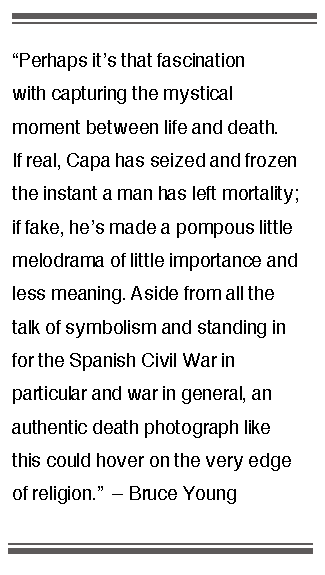 The debate over Capa’s photo and its authenticity was brought about by a man named Jose Manuel Susperregui, a University proffessor who claims his photo is fake.
The debate over Capa’s photo and its authenticity was brought about by a man named Jose Manuel Susperregui, a University proffessor who claims his photo is fake.
“While not mentioned in the article, the Spanish newspaper’s claim is based upon the work of professor José Manuel Susperregui, who teaches communications studies at País Vasco University in Spain, and an analysis that he published in his recent book Sombras de la Fotografía (Shadows of Photography). Professor Susperregui provides compelling evidence that Death of a loyalist militiaman was photographed in Llano de Banda, an area of countryside close to the small village of Espejo, and not in Cerro Muriano (45 km from Espejo), where Capa claims the photo was taken. Historians say there wasn’t a battle in Espejo on September 5, 1936, when the photograph was taken, so the death must have been faked.”
http://heim.ifi.uio.no/~gisle/blog/?p=404 03/11/09
The provided evidence and discussion seems to place Capa in the same position as Walski, a faker who took the chance of creating a dishonest picture. One question that seems pertinent is can Capa and Walski be considered the same?
Walski’s photo had been a digital forgery, using two photos to make the third. Robert Capa’s photo was staged and the difference has to be identified. Capa’s deception seems worse than Walski’s due to several factors. One main reason is because the longevity of the authenticity of the photo, the public feels a stronger sense of deceit compared to Walski as his photo was public for a far shorter time than Capa. The content of the photos is highly relevant because although both photogrphers faked their images in one way or another, Capa’s included death being captured directly infront of the camera, and also the world. Further reserach into the matter surfaced the truth to who the soldier was and how the fake had been manifested.
“We also know, due to an obituary uncovered by Alicante historian Miguel Pascual Mira, that the militiaman depicted in Capa’s photo is not Federico Borrell García as previously thought.”
http://heim.ifi.uio.no/~gisle/blog/?p=404
The issue has raised plenty of discussion and Hugo Doménech and Raúl M. Riebenbauer made a documentary about the debating factors that leads them to the conclusion that the photo is a fake.
The link below leads to a trailer of the documentary, ‘La Sombra Del Iceberg’
Walski had a less extreme subject in his fake and his forgery was simply to emphasise his point, making the photos hard to compare on a contextual basis. However, the fact remains that the photos are both deceitful and their reputations deserve the repercussions.
Wars can generate plenty of competition which might be able to explain the high number of photo fakes during World War 2. The Ukrainian photographer Yevgeny Khaldei had enhanced the smoke in his epic photo of the raising of the flag over the Reichstag in 1945.

http://blogs.photopreneur.com/the-worlds-most-famous-photoshop-fakes 03/11/09
The image below was the ‘original’ photo, although the photo had been staged entirely.


Propaganda…or Advertising?
November 3, 2009During World War 2 enemies and allies used propoganda to spite their opposition and to furhter increase the moral and some sort of revenue. The use of propoganda was highly important to spread lies and hate amongst the population.

http://web.mit.edu/cms/bcc/blogpics/propaganda_prozac.gif 03/11/09
The principals of propoganda are to trick the public into thinking a certain way and to act a certain way. The line between fake photo journalism, staging photos, dishonest advertising and propoganda is blurred because the goals and methods are the same, only slightly less severe in todays world. The fact that lies and mistruths are being deliberately spread for a specific purpose, let it be during a war, or on a front page shows that the intent of those above us aren’t as trust worthy as once thought.
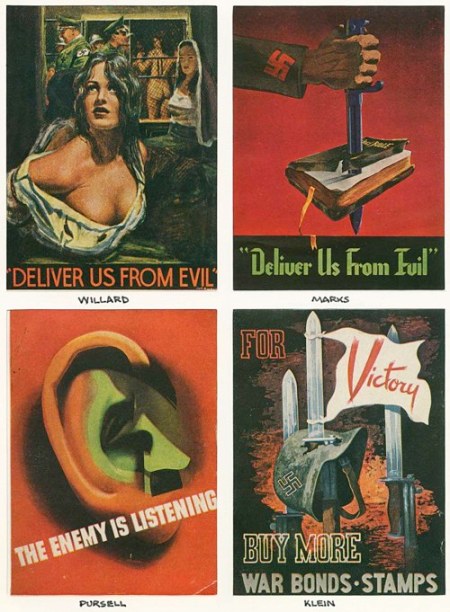 Governments have been doing alterations for their own personal gain for a long time, and unfortunetly discoveries have been made over time telling a different story to what was once originally told.
Governments have been doing alterations for their own personal gain for a long time, and unfortunetly discoveries have been made over time telling a different story to what was once originally told.
